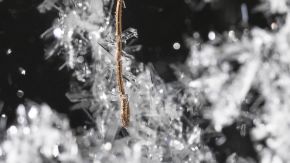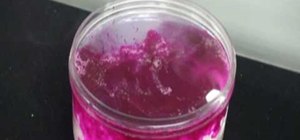“Sodium and water” experiment
Pieces of sodium rapidly run on water
Can we make metal run across water? Let’s find out!

Safety precautions
Only work in protective gloves, glasses and a mask. Observe safety rules when working with flame and flammable objects, and when working with active metals such as lithium, sodium, potassium, rubidium and cesium.
Reagents and equipment:
- metallic sodium;
- 1% sol. phenolphthalein4
- 1% sol. indigo carmine;
- 1% sol. thymol blue;
- glass bowls
Step-by-step instructions
Pour water into the glass bowls, then add the indicator solutions – phenolphthalein to the first, indigo carmine to the second and thymol blue to the third. Add a piece of metallic sodium. Watch the change of color in all three bowls.
Processes description
Sodium is a very reactive metal , and can force hydrogen out of water. When water makes contact with sodium the reaction often takes place with an explosion .
If you throw a small piece of sodium into a bowl of water containing an acid base indicator, you’ll see an impressive effect: the sodium starts to speed across the surface, and it also dissolves, forming a bead which can even ignite, turning into a fiery ball!
Why does sodium run
When it reacts with water, hydrogen is released, which makes the sodium start “running”.
Why does sodium dissolve and ignite
The reaction of sodium with water takes place with an enormous release of heat, which is sufficient to melt metal and turn it into a bead, which is actually a ball of dissolved metal. Additionally, the energy of this reaction is sufficient to ignite the hydrogen released!
Why does the color in the bowls change
Phenolphthalein, indigo carmine and thymol blue are acid base indicators, i.e. substances that change their color when the hydrogen index of the medium changes. When sodium reacts with water , sodium hydroxide is formed, which is a very strong base, and the medium becomes alkaline. Indicators change their color in the following way: phenolphthalein from colorless to crimson, indigo carmine from blue to green, and thymol blue from yellow to blue:
2Na + 2H₂O = 2NaOH + H₂

Dozens of experiments you can do at home
One of the most exciting and ambitious home-chemistry educational projects The Royal Society of Chemistry
- Science, Tech, Math ›
- Chemistry ›
- Projects & Experiments ›

Sodium in Water Chemistry Demonstration
Learn How to Perform This Experiment Safely
Ajhalls / Wikimedia Commons / Public domain
- Projects & Experiments
- Chemical Laws
- Periodic Table
- Scientific Method
- Biochemistry
- Physical Chemistry
- Medical Chemistry
- Chemistry In Everyday Life
- Famous Chemists
- Activities for Kids
- Abbreviations & Acronyms
- Weather & Climate
- Ph.D., Biomedical Sciences, University of Tennessee at Knoxville
- B.A., Physics and Mathematics, Hastings College
The sodium in water chemistry demonstration illustrates the reactivity of an alkali metal with water. This is a memorable demonstration that creates a spectacular reaction for students. Still, it can be performed safely.
What to Expect
A small piece of sodium metal will be placed in a bowl of water. If a phenolphthalein indicator has been added to the water, the sodium will leave a pink trail behind it as the metal sputters and reacts. The reaction is:
2 Na + 2 H 2 O → 2 Na + + 2 OH - + H 2 (g)
The reaction is especially vigorous when warm water is used. The reaction may spray out molten sodium metal and the hydrogen gas may ignite, so use proper safety precautions when conducting this demonstration.
Safety Precautions
- Never use a piece of sodium larger than a pea or pencil eraser .
- Wear safety goggles.
- Perform the experiment behind a clear safety barrier or at a distance from the students.
- Sodium metal stored under mineral oil
- A 250 mL beaker, filled halfway with water
- Phenolphthalein (optional)
- Add a few drops of phenolphthalein indicator to the water in the beaker. (Optional)
- You may wish to place the beaker on an overhead projector or video screen, which will give you a way to show the reaction to students from a distance.
- While wearing gloves, use a dry spatula to remove a very small chunk (0.1 cm 3 ) of sodium metal from the piece stored in the oil. Return the unused sodium to the oil and seal the container. You can use tongs or tweezers to dry the small piece of metal on a paper towel. You may wish to allow the students to examine the cut surface of the sodium. Instruct the students that they can look at the sample but must not touch the sodium metal.
- Drop the piece of sodium into the water. Immediately stand back. As water dissociates into H + and OH - , hydrogen gas will be evolved. The increasing concentration of OH - ions in the solution will raise its pH and cause the liquid to turn pink.
- After the sodium has reacted completely, you can flush it with water and rinse it down the drain. Continue to wear eye protection when disposing of the reaction, just in case a bit of unreacted sodium remained.
Tips and Warnings
Sometimes this reaction is performed using a small piece of potassium metal instead of sodium. Potassium is even more reactive than sodium, so if you make the substitution, use a very small piece of potassium metal and expect a potentially explosive reaction between the potassium and water. Use extreme caution.
- How to Do the Color Change Chameleon Chemistry Demonstration
- Interesting High School Chemistry Demonstrations
- Alchemy Experiment: Turning Water Into Liquid Gold
- Water - Wine - Milk - Beer Chemistry Demonstration
- Create a Magic Genie in a Bottle Effect (Chemistry)
- Halloween Reaction or Old Nassau Reaction
- Color Change Chemical Volcano Demonstration
- Make Potassium Chlorate from Bleach and Salt Substitute
- The Blue Bottle Chemistry Demonstration
- 10 Cool Chemistry Experiments
- Create an Endothermic Reaction
- 10 Fun Chemistry Demonstrations and Experiments
- Briggs-Rauscher Oscillating Color Change Reaction
- Color Change Chemistry Experiments
- 10 Cool Chemistry Demonstrations for Educators
- Sulfuric Acid and Sugar Demonstration

How To : Do a sodium and water experiment

In this video tutorial, viewers learn how to do a sodium and water experiment. Sodium is a silver metal that is very reactive. When exposed oxygen in the air, an outer coding of sodium oxide will form. Simply drop a piece of sodium into a cup of water. When dropped in water, sodium reacts to form sodium hydroxide and hydrogen gas. The sodium will constant move around in the water. Sometimes the heated reaction will cause the nitrogen gas to ignite. Under the right condition, it may even cause an explosion. This video will benefit those viewers who are interested in science and experimenting and would like to learn a new experiment to try.
Just updated your iPhone to iOS 18? You'll find a ton of hot new features for some of your most-used Apple apps. Dive in and see for yourself:
- Control Center
- Home Screen
- Lock Screen
Be the First to Comment
Share your thoughts, make slime without borax : 5 easy recipes for gooey homemade ooze, how to : build a simple paper bridge as a science experiment, how to : make a crazy foam explosion science experiment, how to : make a chemiluminescent reaction with home chemicals, how to : make elephant toothpaste with detergent, hydrogen peroxide & potassium iodide, how to : make this amazing 9-layer density tower from things found in your kitchen, how to : the best investigatory projects in science: 16 fun & easy ideas to kickstart your project, how to : make a monster dry ice bubble, how to : turn milk into strong natural glue with baking soda and vinegar, how to : extract dna from a strawberry with basic kitchen items, news : vortex cannon demolishes house, how to : make your own homemade glow sticks, how to : calculate electrical power, how to : use baby powder to reveal latent fingerprints, classic chemistry : colorize colorless liquids with "black" magic, aka the iodine clock reaction, how to : make a paper plate speaker that actually works for under $1, how to : determine the empirical and molecular formulas for a compound in chemistry, how to : make fake blood from iron, chloride, and potassium, how to : make a permanent, reusable glow stick, how to : make diy nitrogen triiodide from ammonia & water purification iodine crystals.
- All Features
- All Hot Posts

IMAGES
VIDEO
COMMENTS
Sodium and other alkali metals readily oxidize in air and react (sometimes vigorously) with water. The reactivity increases moving down the element group, so sodium is more reactive than lithium, but less r…
Articles. “Sodium and water” experiment. Pieces of sodium rapidly run on water. Can we make metal run across water? Let’s find out! Safety precautions. Only work in protective gloves, …
The sodium in water chemistry demonstration illustrates the reactivity of an alkali metal with water. This is a memorable demonstration that creates a spectacular reaction for students. Still, it can be performed safely.
In this video tutorial, viewers learn how to do a sodium and water experiment. Sodium is a silver metal that is very reactive. When exposed oxygen in the air, an outer coding of sodium oxide will form. Simply drop a …
Reaction of Sodium and Water. Part of NCSSM CORE collection: This video shows the physical properties of Na metal and its reaction with water. http://www.dlt.ncssm.edu...more.
In this classic science experiment, students report on the colours produced when flame tests are carried out on different metal salts.
Explore the production of hydrogen gas and salts when metals react with acids in this class experiment. Includes kit list and safety instructions.
Demonstrate the reactions of sodium, potassium and lithium with water as part of a complete lesson plan on the reactions of alkali metals with water from our Assessment for Learning collection. Fill the trough(s) about half-full of water.
PowerLabs Metallic Sodium Experiments. Introduction: Everyone who has gone through High School Chemistry has seen the “Sodium In Water” experiment. First the periodic table is …